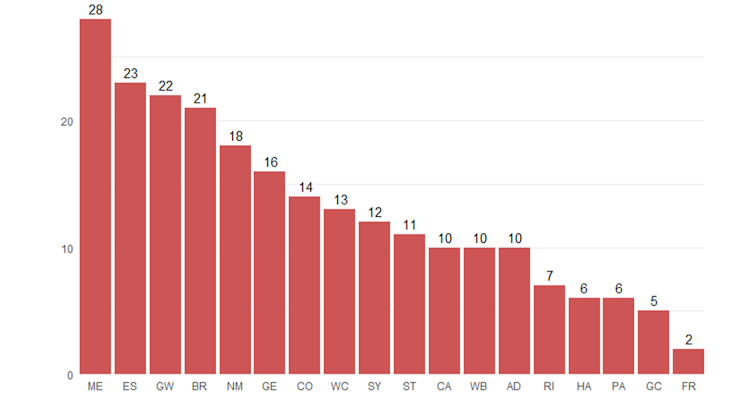AFL Trade Period 2020: What The Numbers Say About Your Club’s Performance
Last updated: Nov 16, 2020, 5:51AM | Published: Nov 15, 2020, 10:00PM
The AFL’s 2020 trade period is over – or at least, the first stage of it is. Trading players appears to be done, trading picks is simply on hiatus.
Some might then say that any analysis of the trades already done is by far too premature – and they may well be right, but who can resist?
Everything said in this article must come with the caveat that clubs can still trade picks up until the draft and even live during the draft. That may reshape some observations in a significant way.
And, the value of draft picks can and will still change as bids are placed and matched in the draft. So these figures will change between now and then, but rest assured it’s a topic we’ll revisit again when the draft is over.
With those disclaimers out the way, onwards! Today we’ll start by looking at just how busy each club got in this year’s trade period, then breaking them down by players and picks in 2020 and 2021.
RELATED: Stats Insider's 2020 AFL Free Agency & Trade Period Tracker
BUSY OR QUIET?

The above chart shows the number of times each club lost or gained an asset of any kind in the 2020 trade period – whether it be a signing a free agent, trading a player, trading a pick, or gaining compensation.
This is one way to measure just how busy each club was during the 2020 exchange – and it may come as a surprise to see that Melbourne were more active than any other side.
The Dees traded Ben Brown in and Mitch Hannan and Braydon Preuss out, but what really kept them busy was pick swaps.
There were only four pure pick swap trades made in this year’s player trade period – and the Demons were involved in all four.
It seems probable that other AFL clubs may be waiting until there’s further clarification on list sizes before they get involved in that kind of trading, but not so the Dees, who have gone in a different direction – and one we’ll discuss more later on.
RELATED: Why Ben Brown To Melbourne Is A Devilishly Good Match
PLAYERS

By sheer count of players in, no club was more active than North Melbourne – but, it’s fair to say the signings of Lachie Youngor Atu Bosenavulagi aren’t quite equivalent to Jeremy Cameron landing at Geelong.
So instead the above chart looks at the net gain or loss for each club in terms of the games played in the last two years by players entering or exiting.
Geelong, Carlton, the Bulldogs, St Kilda and Port Adelaide stand out as the five clubs who are +50 or more in this count. Four of them are finals sides, all five are clubs looking to win now.
At the other end of the scale Adelaide, GWS and Collingwood have all lost some regular players from recent years.
Brisbane, too, stand out as despite losing two and gaining two, they sit near the bottom of the order in this stat.
Their recruits – Joe Daniher and Nakia Cockatoo – have played just 8 games between them in this time period.

We can look at coaches votes rather than games played if we want to better measure the quality of each player’s output over the last two years.
The Cats are on top here again but by a much bigger margin, showing just how good their trio of recruits – Cameron, Shaun Higginsand Isaac Smith – have been in the recent past.
If those players keep up that level of performance – and it is an “if”, given the ages of Higgins and Smith – then Geelong are in for a big boost.
After featuring high previously, Port Adelaide and Hawthorn drop back a little here, while Melbourne rise up the ranks a little.
With Geelong, the Bulldogs, Carlton and St Kilda all featuring highly in both charts, it’s clear those sides will be expecting to benefit from their player acquisitions in 2021.
At the other end of the scale, Essendon, Adelaide, Collingwood and GWS all feature in the bottom five on both charts.
That’s not the end of the world, but it does suggest that those clubs will need to see other talents rise to the challenge if they’re to avoid a decline in form.
RELATED: Collingwood Football Club Total Landscaping
2020 PICKS

This chart shows the net gain or loss of Draft Value Index (DVI) for each AFL club – the ‘draft points’ as set by the AFL for the father-son and academy bid-matching process.
The DVI isn’t a perfect evaluation of the value of draft picks – far from it. But it can be a handy way to look at the sum value of a group of picks, something that is otherwise hard to do.
I would say the most important thing to remember is that while equivalents are fun and interesting, they’re not real.
GWS and Essendon for example have gained more than the equivalent of pick 1 this year – but they haven’t actually gained pick 1, nor have Geelong traded it out.
The fact that there’s a scarcity of list spots available in the AFL means a single pick worth 2000 DVI is worth more than two picks of 2000 combined – which is why clubs looking to gain points for bid matches always find it easy to trade down the order.
That’s what Sydney and the Western Bulldogs have done (and may continue doing) this year – gaining more than 500 points each in the 2020 draft to match bids on their respective academy prospects.
Of the four clubs we identified as losing big on players, GWS and Essendon have brought in big draft hauls in return, while Collingwood and Adelaide haven’t – at least not in this year’s draft.
Melbourne have gained a significant bounty of 2020 DVI despite not trading out any truly valuable players, while Geelong and Brisbane have moved a lot of value out – but we’re about to see why.
RELATED: Why St Kilda And Jack Higgins Are A Match Made In Heaven
2021 PICKS

This chart also looks at DVI in and out – but the picks are for the 2021 draft, and the DVI is approximate based on the average value of a pick in that round.
That’s not necessarily very nuanced as it would approximate Adelaide and Richmond’s 2021 picks to be of the same value when they certainly won’t – but for now at least, I prefer a simple approximation to guesswork.
What’s noticeable is that both the Cats and the Lions have gained some significant assets in next year’s draft. Brisbane traded out of 2020 to get into 2021, while Geelong got two future seconds through the door in the Jeremy Camerontrade.
Melbourne’s 2020 gains are almost entirely balanced out by their 2021 losses. In fact they’ve traded out their future picks in Round 1, 2, 3, and 4 of next year’s draft – but gotten back picks from other clubs in every round but the first.
Adelaide and Collingwood’s numbers here also mitigate their poor 2020 returns for traded players to some degree, though the Pies in particular have still clearly done pretty poorly in terms of value in for value out.
Compared to Essendon for example it could be said that Collingwood have lost a similarly talented crop of players, but done several orders of magnitude worse in terms of the draft capital they got in return – no doubt due to reported salary cap pressures forcing them to accept under-value offers.
RELATED: Which AFL Clubs Actually Have The Best Young Talent?
CLOSING THOUGHTS
It’s not news that Collingwood haven’t done great or that the likes of Geelong and Carlton are expecting to get a big boost from their trade recruits – that much is readily apparent even before looking at the numbers.
The one thing I would say about the before moving on, of course, is that even a cursory examination of past trade periods makes it clear that one plus one does not always equal two – nor the reverse.
Adding new players to a team is a tricky business and sometimes, often in fact, doesn’t make for a significant overall improvement.
Likewise, sometimes taking players away can provide the opportunity for others to step up, mitigating the loss of talent.
As well illustrated here on Stats Insider by Marc McGowan just last week, we tend to have an overinflated view of just how much the trade period will really impact our teams.
So, don’t start stressing (or celebrating) too much just yet. Rarely are things as good or as bad as they may seem.
Another thing I would say quickly about Jeremy Cameron is that reports saying he was trade for “three first rounders” are technically correct, but not a great way to look at the deal.
The earliest of those picks was 13 – a middle-to-late selection – and the latest was 20, which only qualifies due to the bloating of the first round by compensation picks.
And as mentioned, the Cats did also get back those two future second-rounders. No one gets excited about trading in a future second, but when the future actually arrives, they are often valuable.
Onto other topics: probably the most notable trend that hasn’t been heavily discussed in the media is the interesting moves made by Melbourne.
While other clubs are wary of this year’s draft crop and of making pick swaps before list sizes are confirmed, the Dees have dived right into both.
It’s the fourth time in six years that they have traded out a future first-round pick – once for Jake Lever, three times to get more picks into the present draft.
Whether or not that’s a wise strategy remains to be seen but it certainly is a bold one. They’re the only team so far to have traded out their 2021 first – with next year’s draft by all reports set to be a strong one.
Perhaps history will prove the Dees right and the 2020 draft will be a more talented crop than we currently expect. If so, Melbourne will look like geniuses.
Probably the other club whose numbers stand out to me is Brisbane.
They’ve been lauded for the signings of Joe Daniher and Nakia Cockatoo, but a less kind assessment of their trade period would be to say they’ve lost players who actually do get on the park for some who don’t.
There’s no doubt that Brisbane have had an excellent run with injury over the last two years and the revivals of traded-in players Lincoln McCarthy and Grant Birchall has been a part of that.
But is that a genuine sustainable advantage, or just a hot hand? My worry is that we’ve seen clubs have good runs like this before only to regress to the mean – Brisbane may well do the same.
If Daniher and/or Cockatoo come good they’ll no doubt be significant additions to the team. Both are special talents, and I’d love to seem the flourish at AFL level.
That said, I wouldn’t be shocked if someday we’re looking back on this trade period to find that Alex Witherdendid a lot more at West Coast than either of them did in Brisbane.
Did you enjoy this article? Join our free mailing list to get the best content delivered straight to your inbox, or join the conversation by leaving a comment below or on the Stats Insider Twitter or Facebook page.



